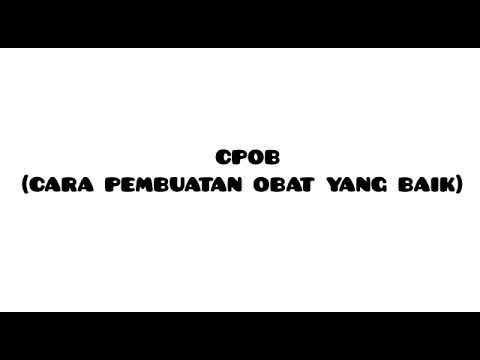Part 1 CPKB (Cara Pembuatan Kosmetik yang Baik)
Summary
TLDRThis video script discusses the creation of Good Cosmetics or CPKB, which ensures products meet quality standards for their intended use. It highlights the cosmetic industry's two classifications, A and B, with A having a pharmacist in charge and B requiring a technical pharmaceutical representative. The script outlines the 12 aspects of the CPKB application, including quality management systems, personnel, facilities, sanitation, and quality control. It also emphasizes the importance of documentation, such as organizational structure, operational procedures, and labeling. The video concludes with a brief mention of hygiene and health checks for production personnel.
Takeaways
- 😀 The video discusses the process of creating good quality cosmetics, known as CPKB (Good Cosmetics Production Practice).
- 🛠️ CPKB involves all aspects of cosmetic production to ensure products meet quality standards and are fit for their intended use.
- 📄 Compliance with CPKB is demonstrated through a CPKB certificate and B certificate, showing adherence to quality guidelines.
- 🏭 The cosmetic industry is divided into Class A and Class B, with Class A having a pharmacist as the technical responsible person and Class B having a pharmaceutical technician.
- 🚫 Class B cosmetic industry is prohibited from producing certain types of cosmetics, including those used around the eyes, mouth, and mucous membranes, and those containing acne ingredients, skin lightening agents, sunscreens, chemical peels, and hair dyes.
- 🔬 High-technology cosmetics such as aerosols and compact powders are also part of the industry.
- 📋 The CPKB certification application consists of 12 aspects, including quality system documentation, personnel, facilities, care place, sanitation, hygiene, production, quality control, documentation, internal audit, storage, contract production, and testing and complaint handling.
- 🧼 Hygiene and sanitation are key components of the CPKB documentation, covering personal hygiene, health checks for production personnel, cleanliness of rooms, and sanitation of equipment.
- 📝 Documentation is a crucial part of the application, including organizational structure specifications, operational programs, procedures, and operational protocols (POP), as well as records.
- 🏷️ Labeling is also an important aspect of CPKB, ensuring proper identification and information about the cosmetic products.
- 👋 The video concludes with an invitation to the next explanation, indicating a series of educational content on the topic.
Q & A
What is the main topic of the video?
-The main topic of the video is the discussion of good cosmetic manufacturing practices (GMP) and the certification process for cosmetic products in Indonesia.
What does 'CPKB' stand for in the context of the video?
-In the context of the video, 'CPKB' stands for 'Ciri-ciri Pabrik Kosmetik Baik,' which translates to 'Good Cosmetic Factory Characteristics' in English.
What are the two types of cosmetic industries mentioned in the video?
-The two types of cosmetic industries mentioned are Group A, which has a pharmacist as the technical responsible person, and Group B, which has a pharmaceutical technician as the technical responsible person.
What are the products that are prohibited to be produced by Group B cosmetic industry?
-The products prohibited for production by the Group B cosmetic industry include cosmetics used around the eyes, mouth, and mucous membranes, anti-acne products, skin bleaching agents, sunscreens, chemical peeling, and hair dyes.
What does the certification process for CPKB involve?
-The certification process for CPKB involves demonstrating compliance with various aspects of good manufacturing practices, including obtaining a PKB certificate and fulfilling the 12 aspects of the CPKB standard.
What are the 12 aspects of the CPKB standard mentioned in the video?
-The 12 aspects of the CPKB standard include quality management system, personnel, building and facilities, care place, sanitation and hygiene, production, quality control, documentation, internal audit, storage, production contract, and complaint handling and product recall.
What is the significance of having a quality management system in the context of CPKB?
-A quality management system is significant in the context of CPKB as it ensures that the manufacturing processes are controlled and monitored to meet the quality requirements of the cosmetic products.
What does 'hygiene and sanitation' in the CPKB standard encompass?
-In the CPKB standard, 'hygiene and sanitation' includes personal hygiene, health checks for production personnel, cleanliness and sanitation of the rooms, and cleanliness and sanitation of the equipment.
What is the role of documentation in the CPKB certification process?
-Documentation plays a crucial role in the CPKB certification process as it includes specifications, organizational structure, standard operating procedures, and records that demonstrate compliance with the quality standards.
What is the purpose of the internal audit in the CPKB standard?
-The purpose of the internal audit in the CPKB standard is to regularly assess and ensure that the company's processes and systems are in line with the quality management system and are effectively implementing the CPKB requirements.
How does the video conclude?
-The video concludes with a sign-off, indicating that the explanation of CPKB is complete and the audience can look forward to the next explanation, followed by applause and music.
Outlines

هذا القسم متوفر فقط للمشتركين. يرجى الترقية للوصول إلى هذه الميزة.
قم بالترقية الآنMindmap

هذا القسم متوفر فقط للمشتركين. يرجى الترقية للوصول إلى هذه الميزة.
قم بالترقية الآنKeywords

هذا القسم متوفر فقط للمشتركين. يرجى الترقية للوصول إلى هذه الميزة.
قم بالترقية الآنHighlights

هذا القسم متوفر فقط للمشتركين. يرجى الترقية للوصول إلى هذه الميزة.
قم بالترقية الآنTranscripts

هذا القسم متوفر فقط للمشتركين. يرجى الترقية للوصول إلى هذه الميزة.
قم بالترقية الآن5.0 / 5 (0 votes)






